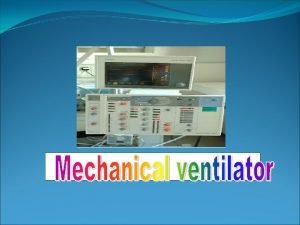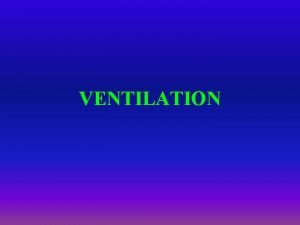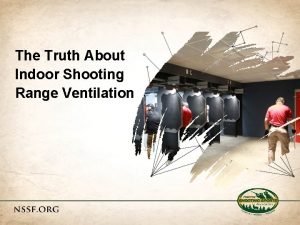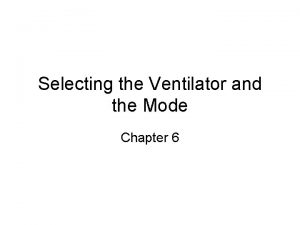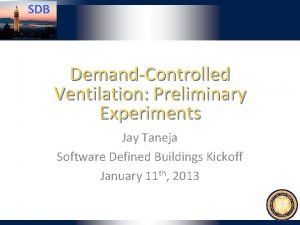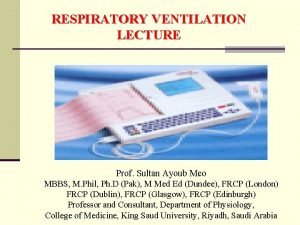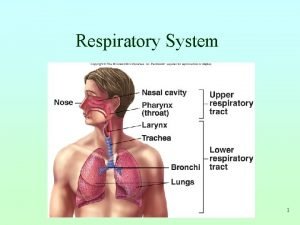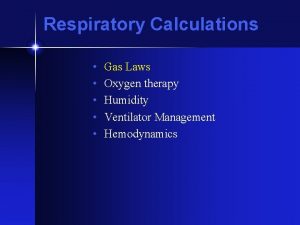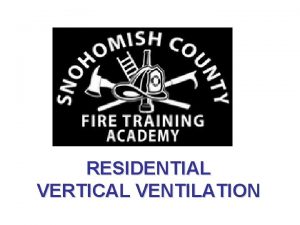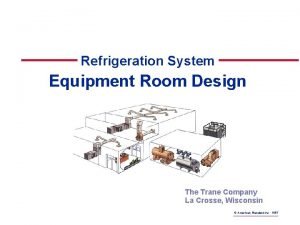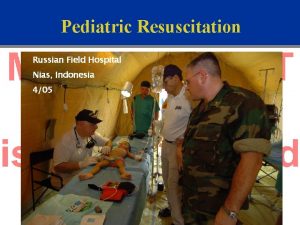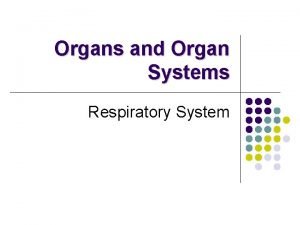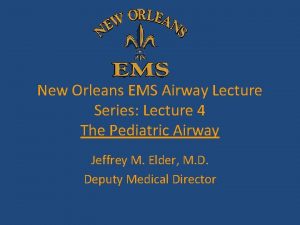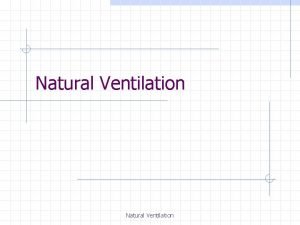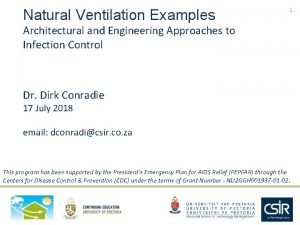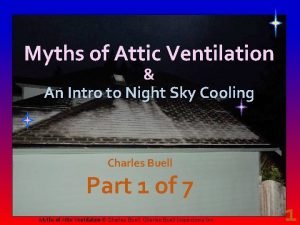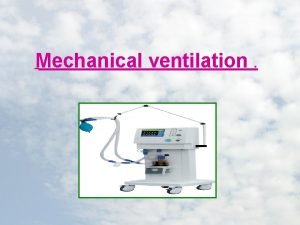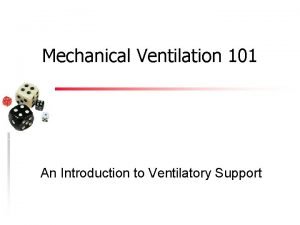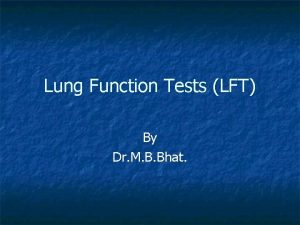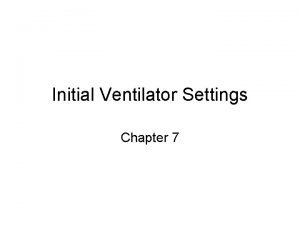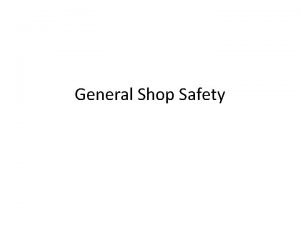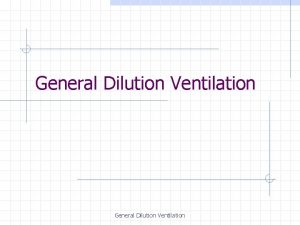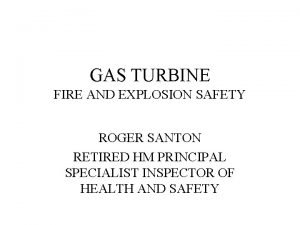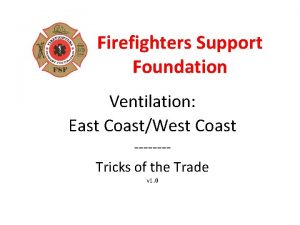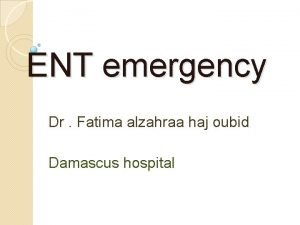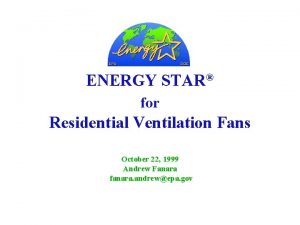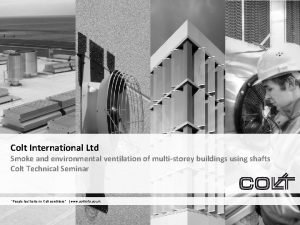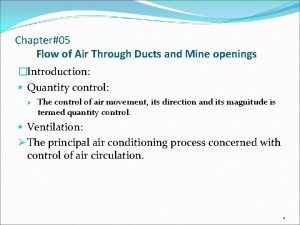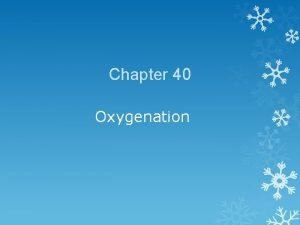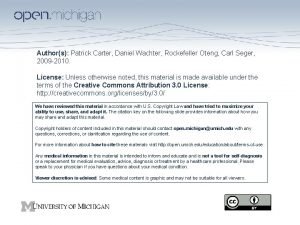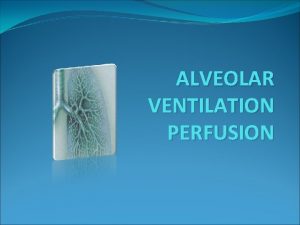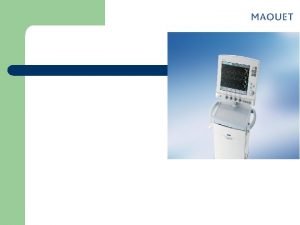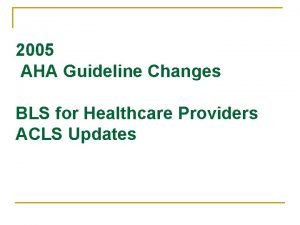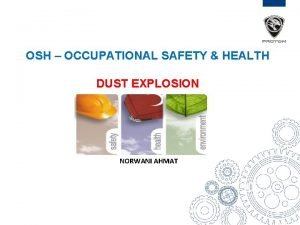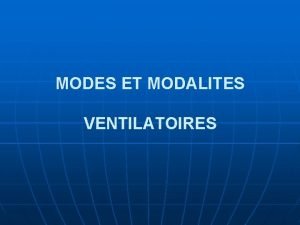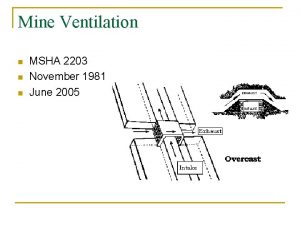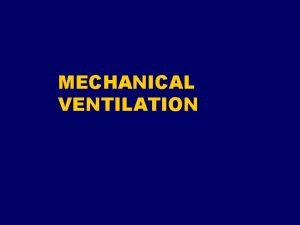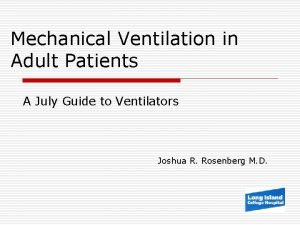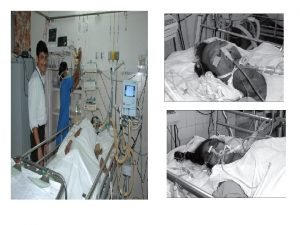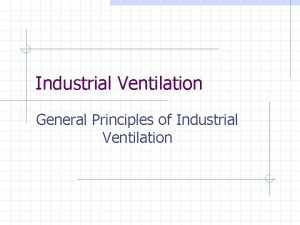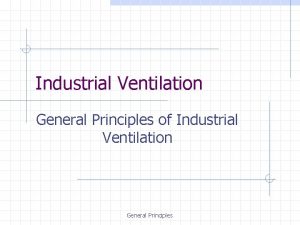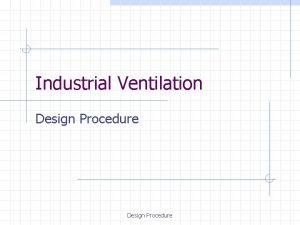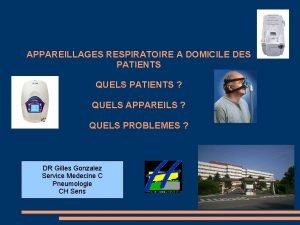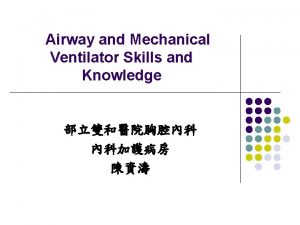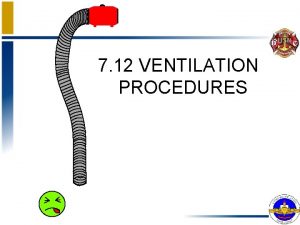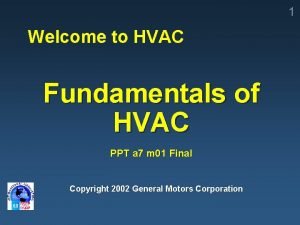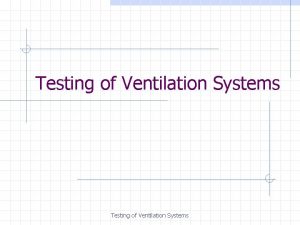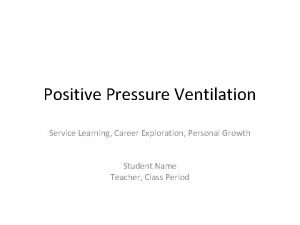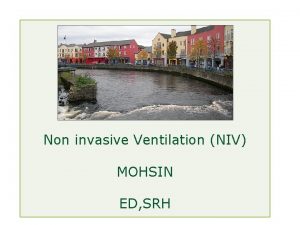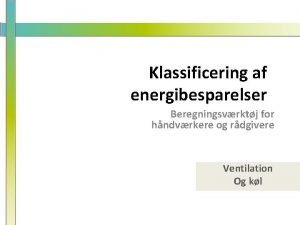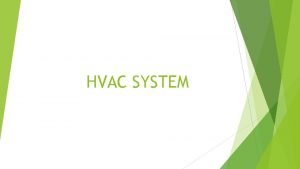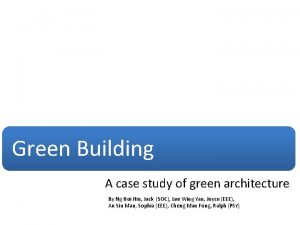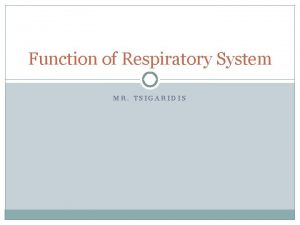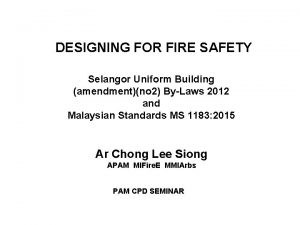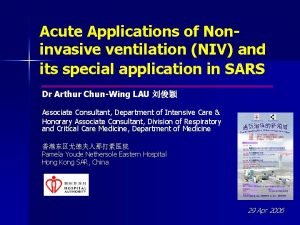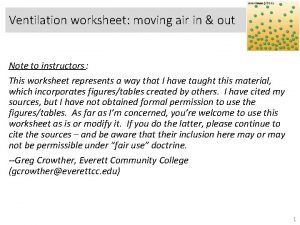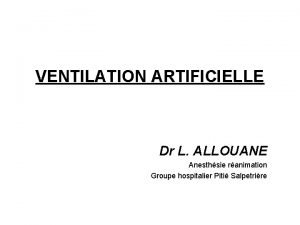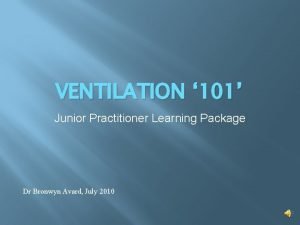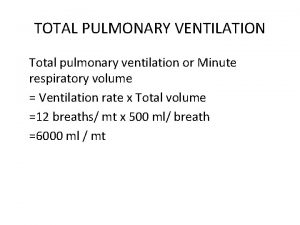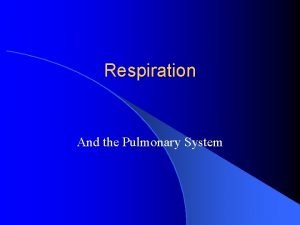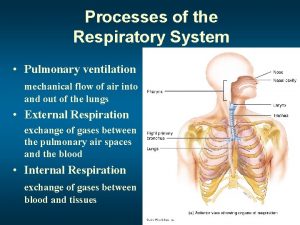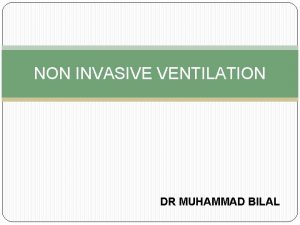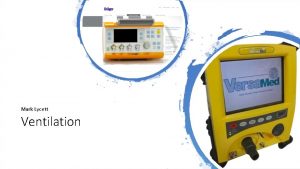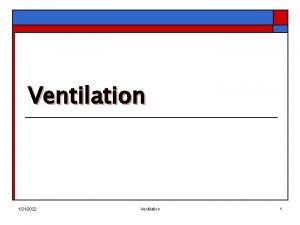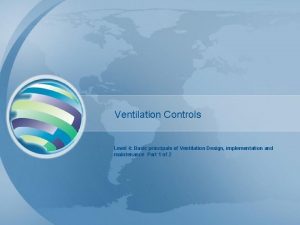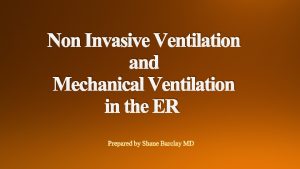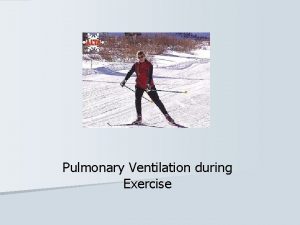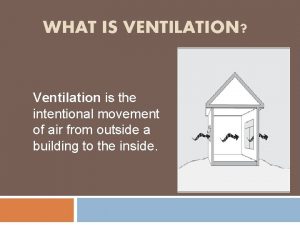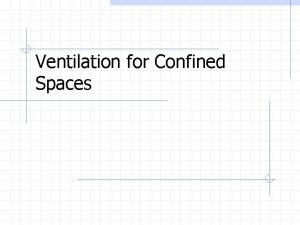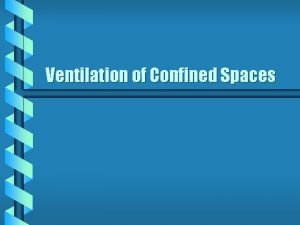Lesson Topic 2 2 VENTILATION Lesson Topic 2














































































- Slides: 78

Lesson Topic 2. 2 VENTILATION

Lesson Topic 2. 2, Ventilation Introduction As Gas Free Engineer Personnel you will be required to know the various methods and equipment used for ventilation in preparation for and during gas free operations.

Lesson Topic 2. 2, Ventilation Enabling Objectives Describe General, Dilution, Supply, Exhaust, and Local Exhaust ventilation and required air changes prior to entry into an enclosed and/or confined spaces in accordance with NSTM Chapter 074 Vol. 3, Gas Free Engineering. n Describe the characteristics, maintenance, and safety precautions for the Ramfan 2000 blower in accordance the RAM FAN manufacturer's technical manual. n

Lesson Topic 2. 2, Ventilation Enabling Objectives Describe how to perform set-up procedures to include the determination of the number of blowers required, Location of blowers, Layout of exhaust ducting in accordance with NSTM Chapter 074 Vol. 3, Gas Free Engineering. n Calculate the rate of exhaust ventilation or supply air needed to provide adequate ventilation in accordance with NSTM Chapter 074 Vol. 3, Gas Free Engineering. n

Lesson Topic 2. 2, Ventilation is defined as the introduction and movement of fresh air into a space to remove contaminated air, or to control the temperature of the space or tank.

TEMPERATURE COMBUSTION THRESHOLDS Ignition Temperature Is? Fire Point Is? Flash Point Is? Minimum temperature at which self sustained combustion occurs without an external ignition source. Temperature at which sufficient vapors are released to support continuous combustion once ignited. Minimum temperature at which sufficient vapors are released to form an ignitable mixture.

Lesson Topic 2. 2, Ventilation is required for è Steaming of tanks è Cleaning of tanks è Oxygen deficient atmospheres è Explosive atmospheres è Toxic atmospheres è After fire è Routine movement of air aboard ships

VENTILATION - LIMITATIONS n Flammable, O 2 deficient or enriched atmospheres are the result of inadequate natural or mechanical ventilation n Ship configuration, portable blowers availability, duct limits restrict ventilation n Providing temporary ventilation using portable fans or blowers can limit hazards to an acceptable level

VENTILATION OBJECTIVES n Remove contaminated air from space n Limit flammable atmospheres to 10% or less of LEL n Limit toxic concentrations to PEL n Capture & remove contaminants or dilute to safe levels n Provide fresh, breathable air for health and comfort

VENTILATION PRIOR TO ENTRY “There will be a minimum of two air changes prior to entry into a confined space unless installed ventilation is in operation” NSTM 074 -21. 3

EXAMPLE n n SPACE 20 ft X 10 ft = 2000 ft 3 RAMFAN VOLUMETRIC FLOW RATE = 2000 FT 3 / MIN How many minutes needed for two complete air changes? 2 MINUTES NEEDED FOR 2 COMPLETE AIR CHANGES

Lesson Topic 2. 2, Ventilation Types of Ventilation WARNING: PRIOR TO ANY VENTILATION, THE GFE MUST DETERMINE IF THE SPACE PRESENTS AN UPPER EXPLOSIVE LIMIT (UEL) DANGER. IF A UEL CONDITION OR THE POTENTIAL EXISTS, HAVE APPROPRIATE FIREFIGHTING ASSESTS STANDING BY. PROCEED WITH CAUTION. SECURE THE HEAT OR FUEL SOURCE AS THE SITUATION DICTATES AND RIG GROUNDED EXHAUST VENTILATION.

Lesson Topic 2. 2, Ventilation Types of Ventilation u Natural » The natural movement of air throughout a space. u Mechanical » The use of electrical or pneumatic fans » Provides supply or exhaust air

Lesson Topic 2. 2, Ventilation Types of Ventilation u Supply » Moving fresh air into a space or compartment and displacing contaminated air through any available opening.

Lesson Topic 2. 2, Ventilation Types of Ventilation WARNING: NEVER BLOW AIR INTO A SPACE THAT CONTAINS FLAMMABLES, TOXIC PARTICLES OR TOXIC ATMOSPHERES.

Lesson Topic 2. 2, Ventilation Types of Ventilation u Exhaust » Removing air from a space or compartment. » Less efficient air movement than supply. » Better method of control and removal of particle contaminants.

EXHAUST CONFIGURATION PREFERRED OVER SUPPLY n Supply can produce a static charge build- up n Supply could introduce foreign objects into space n Supply can result in contamination of adjacent spaces


Lesson Topic 2. 2, Ventilation Types of Ventilation u General » Provides uncontaminated air for breathing and to maintain general comfort of personnel. » It may be used to maintain concentrations of toxic and flammable atmospheres at acceptable levels where the sources of such contaminants are small and evolution of airborn contaminants is low. » The requirement for general ventilation is one complete air change every three minutes.

Lesson Topic 2. 2, Ventilation Types of Ventilation u General ventilation Note: In a confined space there will be two complete air changes prior to entry.

Lesson Topic 2. 2, Ventilation Types of Ventilation u Local exhaust » Positioning exhaust intake 6 - 10 inches from the work area to draw or carry contaminants away.

Lesson Topic 2. 2, Ventilation Types of Ventilation u Local exhaust » Positioning exhaust intake 6 - 10 inches from the work area to draw or carry contaminants away. » To be effective, the work zone farthest from the exhaust inlet requires an air flow of 100 feet per minute (FPM) towards the exhaust.



Lesson Topic 2. 2, Ventilation Types of Ventilation WARNING: ALWAYS SUPPLY PERSONNEL WITH NIOSH APPROVED RESPIRATORY PROTECTION EQUIPMENT FOR WORKING WITH HIGHLY TOXIC MATERIALS SINCE EVEN SLIGHT VENTILATION SYSTEM TROUBLE MAY RESULT IN SIGNIFICANT PERSONNEL EXPOSURE

Lesson Topic 2. 2, Ventilation Types of Ventilation u Dilution » Used to draw air out of a space with portable ventilation and replacing the stagnant air with fresh air drawn in by natural air circulation.

Lesson Topic 2. 2, Ventilation Types of Ventilation u Dilution » Used to draw air out of a space with portable ventilation and replacing the stagnant air with fresh air drawn in by natural air circulation. » Used when effective local exhaust ventilation is impossible due to the nature of the space or other factors. WARNING: RESPIRATORY PROTECTION MUST BE WORN

DILUTION VENTILATION VOLUME FORMULA n One complete air change every 3 minutes n If welding, results compared to NSTM 074 vol 3 requirements on page 21 -6

DILUTION FOR SPRAY PAINTING u. Ventilation shall dilute contaminants to 10% or < of the LEL u. Ventilate continuously during and then afterward u. Test as necessary during operations u. If concentrations of flammable vapors exceeds 10% of the LEL, STOP operations, continue ventilation

98 -00001 3 Ventilation Options: USS NAVIN R. JOHNSON Local Exhaust Ventilation: CHAIN LOCKER (5 -84 -0 -Q) CLEAN AND Ex. : INSPECT Welding, 1300 26 JAN 98 Painting, 26 JAN 98 2100 Using Solvents DILUTION - 1 RAMFAN EXHAUSTING FROM SPACE Dilution Ventilation THROUGH WTD 4 -92 -1 TO WEATHER. CONTINUOUS OPERATION WHILE PERSONNEL IN SPACE. Ex. : Reducing Toxins, N/A Controlling Flammable Vapors General Exhaust Ventilation ALL PERSONNEL USE RHINE AIR PUMP, AND COVERALLS. RE-INSPECT EVERY TWO HOURS. SAFETY Ex. : Providing Cool Comfort Air in a Atmosphere OBSERVER MAINTAIN COMMS WITH WORKERS AND RESCUE CONTROL POINT USING WIFCOM. Hazard-Free

Lesson Topic 2. 2, Ventilation Air Moving Devices

Lesson Topic 2. 2, Ventilation Air Moving Devices n Installed or fixed systems – Not designed for GFE applications. – Can be used with restrictions: » Chief engineers permission » Does not discharge into another space. » All ducting is inspected prior to use.

Lesson Topic 2. 2, Ventilation Air Moving Devices n Portable ventilation equipment – Ram Fan 2000 » Operated by pressurized water (Between 40 -180 PSI) » Lightweight - 35 lbs » Rated at 2000 CFM » Explosion proof » 1 1/2" swivel inlet and outlet fitting

Lesson Topic 2. 2, Ventilation Air Moving Devices n Maintenance – Inspections should be made on a planned schedule to check operation of equipment. – A preventive maintenance system schedule that calls for thorough regular checks on all ventilation equipment will prevent costly slowdowns and work stoppages due to breakdowns on the job.

Lesson Topic 2. 2, Ventilation Fan and Ducting Locations

VENTILATING FLAMMABLE ATMOSPHERES n Equipment explosion proof or intrinsically safe n Equipment grounded to control static electricity

BLOWING VS DRAWING “NEVER BLOW AIR INTO A SPACE WHICH CONTAINS FLAMMABLE OR TOXIC PARTICLES” NSTM 074 -21. 6. 4

WHEN MAY I BLOW AIR INTO A SPACE?

BLOWING AIR ÖNo flammables present or being generated ÖNo toxics present or being generated ÖOnly to provide clean air for breathing and comfort

DUCTING n Greater length and bends results in greater friction n Maximum of three 15 ft ducts per fan

Lesson Topic 2. 2, Ventilation Fan and ducting locations n Exhaust fans or blowers shall be located on the weather deck whenever possible so that the exhaust ducts within the ship are under negative pressure. n Locating fans or blowers at the exhaust inlet would result in a positive pressure on exhaust ducts and potential leakage of flammable or toxic atmosphere into other ship spaces.

Lesson Topic 2. 2, Ventilation Fan and ducting locations n General considerations in selecting a blower are: – Volume of air to be moved – Type and amount of motive power available – Initial atmospheric test results – Potential hazards

Lesson Topic 2. 2 Ventilation Fan and ducting locations n Duct work – Duct work and tubing are necessary in most ventilation systems to direct, hold pressure, and contain the supplied or exhausted air. – Arrangement, position, and direction are important. Duct work should be as short as possible, with bends and elbows at a minimum, to reduce friction loss.

Lesson Topic 2. 2, Ventilation Fan and ducting locations n Duct work – Types of duct work » Galvanized sheet metal duct 4 Used in large jobs 4 Most effective » Non-collapsible tubing 4 Restricted spaces

Lesson Topic 2. 2, Ventilation Fan and ducting locations n Duct work – Types of duct work (Cont’d ) » Collapsible tubing n Discharge side of fan » Flexible metal hose n Used for suction or discharge n Good for local exhaust in welding and burning operations n Comes in various lengths and sizes

Lesson Topic 2. 2, Ventilation situations and duct locations

SHORT CIRCUITING n Source of make up air is too close to the exhaust trunk n Effective volume ventilated is insufficient n Remedy? Place trunk further into space

SHORT CIRCUITING

SHORT CIRCUITING

SHORT CIRCUITING

SHORT CIRCUITING

SHORT CIRCUITING

RECIRCULATION OF CONTAMINATED AIR n Exhaust discharge is drawn back into the make- up air n Drawn back into space

RECIRCULATION

RECIRCULATION

RECIRCULATION

RECIRCULATION

RECIRCULATION

RECIRCULATION

RECIRCULATION

RECIRCULATION

Lesson Topic 2. 2, Ventilation Fan and ducting locations Short Circuiting

Lesson Topic 2. 2, Ventilation Fan and ducting locations Short Circuiting Cure the Problem

Lesson Topic 2. 2, Ventilation Fan and ducting locations Recirc of Exhaust

Lesson Topic 2. 2, Ventilation Fan and ducting locations Recirc of Exhaust Cure the Problem

Lesson Topic 2. 2, Ventilation Fan and ducting locations Vapors lighter than air

Lesson Topic 2. 2, Ventilation Fan and ducting locations Vapors heavier than air

Lesson Topic 2. 2, Ventilation Fan and ducting locations Nice and safe ventilation

THUMBRULES FOR VENTILATION TO MAINTAIN A GAS FREE CONDITION J Always suspect a hazardous condition to exist or be created J Personnel involved in the work or space entry process must either wear or have ready the proper respiratory gear for the hazard suspected

When in doubt, expect the worst ?

Lesson Topic 2. 2, Ventilation Calculating the rate of exhaust and supply air

Lesson Topic 2. 2, Ventilation Calculating the rate of exhaust and supply air. L x W x H = V (Volume)

Lesson Topic 2. 2, Ventilation Calculating the rate of exhaust and supply air. L x W x H = V (Volume) V CFM ( Rated capacity of the blower) = Time

Lesson Topic 2. 2, Ventilation Calculating the rate of exhaust and supply air. L x W x H = V (Volume) V CFM ( Rated capacity of the blower) = Time 3 = # Blowers

Lesson Topic 2. 2, Ventilation Calculating the rate of exhaust and supply air. L x W x H = V (Volume) V CFM ( Rated capacity of the blower) = Time Round it up… #^!@$*)^ 3 = # Blowers

Lesson Topic 2. 2, Ventilation Review and Summary

Lesson Topic 2. 2, Ventilation Review and Summary Ventilation n Air Moving Devices n Fan and ducting locations n Calculating the rate of exhaust and supply air. n

Lesson Topic 2. 2, Ventilation ANY QUESTIONS?
 Ventilation modes
Ventilation modes Examples of clinchers
Examples of clinchers Narrow
Narrow Local exhaust ventilation definition
Local exhaust ventilation definition Air dilution
Air dilution Indoor shooting range ventilation
Indoor shooting range ventilation Mode of ventilation
Mode of ventilation Ventilation sdb
Ventilation sdb Conducting zone vs respiratory zone
Conducting zone vs respiratory zone Respiration vs ventilation
Respiration vs ventilation Desired fio2 formula
Desired fio2 formula Ladder placement for ventilation
Ladder placement for ventilation Ashrae standard 15 refrigerant monitor
Ashrae standard 15 refrigerant monitor Bag mask ventilation
Bag mask ventilation Infant compression to ventilation ratio
Infant compression to ventilation ratio Windpipe cells
Windpipe cells Bag mask ventilation
Bag mask ventilation Natural ventilation calculation
Natural ventilation calculation Examples of natural ventilation
Examples of natural ventilation 5 myths about attic ventilation
5 myths about attic ventilation Cpap for dummies
Cpap for dummies Pressure support ventilation
Pressure support ventilation Minute ventilation
Minute ventilation Dyspnea index calculation formula
Dyspnea index calculation formula Normal minute ventilation
Normal minute ventilation Greenhouse ventilation calculator
Greenhouse ventilation calculator General shop safety rules
General shop safety rules Dilution ventilation equation
Dilution ventilation equation Gas turbine enclosure ventilation
Gas turbine enclosure ventilation East coast fire and ventilation
East coast fire and ventilation Rensluckor
Rensluckor Mechanical ventilation firefighting
Mechanical ventilation firefighting Bag mask ventilation
Bag mask ventilation Residential ventilation fans market
Residential ventilation fans market Ventilation
Ventilation Atkinson equation ventilation
Atkinson equation ventilation Lifestyle factors affecting oxygenation
Lifestyle factors affecting oxygenation Chest compression for infant 2 rescuer
Chest compression for infant 2 rescuer Dope in mechanical ventilation
Dope in mechanical ventilation Bag mask ventilation
Bag mask ventilation Vd vt ratio
Vd vt ratio Aprv indications
Aprv indications T-piece ventilation
T-piece ventilation Compression to ventilation ratio adults
Compression to ventilation ratio adults As 91155
As 91155 General dilution ventilation
General dilution ventilation Ventilation artificielle
Ventilation artificielle Mine ventilation
Mine ventilation Vent modes
Vent modes Pressure support vs pressure control
Pressure support vs pressure control Peep nursing
Peep nursing Ventilation artificielle
Ventilation artificielle Mr sopa
Mr sopa Types of industrial ventilation
Types of industrial ventilation General exhaust ventilation
General exhaust ventilation Industrial exhaust hood design
Industrial exhaust hood design Ventilation auto asservie
Ventilation auto asservie Malampti
Malampti Ventilation calculation formula for confined space
Ventilation calculation formula for confined space Ppt
Ppt Ventilation system testing
Ventilation system testing Vertical ventilation definition
Vertical ventilation definition Non invasive ventilation
Non invasive ventilation Beregningsværktøj håndværkere
Beregningsværktøj håndværkere Bms ventilation
Bms ventilation Natural ventilation
Natural ventilation Pulmonary ventilation consists of two cyclic phases,
Pulmonary ventilation consists of two cyclic phases, Florence nightingale environment theory
Florence nightingale environment theory Uniform building by law selangor
Uniform building by law selangor Non invasive ventilation
Non invasive ventilation Confined space ventilation calculation worksheet
Confined space ventilation calculation worksheet Ventilation artificielle
Ventilation artificielle Ventilation learning package
Ventilation learning package Respiratory membrane
Respiratory membrane Inspiration anatomy and physiology
Inspiration anatomy and physiology Type of respiration
Type of respiration Pulmonary ventilation
Pulmonary ventilation Circulation practitioner
Circulation practitioner Rocking bed ventilation
Rocking bed ventilation
